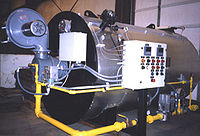Difference between revisions of "Heating Systems"
(Created page with "Category:Heating{{Knoppen}} <noinclude><!------------------------------------------------ * READ THIS FIRST * Only edit this page if you can improve the content. * Improper ...") |
PurplePen19 (talk | contribs) |
||
| Line 7: | Line 7: | ||
* Please start editing this page after the /noinclude | * Please start editing this page after the /noinclude | ||
* -------------------------------------------------></noinclude> | * -------------------------------------------------></noinclude> | ||
This | [[File:Heating system.jpg|thumb|200px|right|Heating system]] | ||
'''Heating system''' is replacing heat that is lost through the system. How much energy your heating system requires to replace that heat depends on four factors: the climate where the house is located, the home's size, how energy-efficient the house is, and how energy-efficient the heating system is. | |||
==Efficiency== | |||
Not all of the energy potentially available in a ton of coal, a cubic foot of natural gas, or a gallon of oil ends up as usable heat in the home. Energy is lost in a number of places in the conversion and distribution process. The heating system efficiency is the ratio between the amount of usable heat produced and the amount of potential energy in the fuel. | |||
A number of efficiency measures have evolved to allow useful comparisons to be made between systems. The three main types of heating efficiency are: Combustion (which looks only at the efficiency of the combustion process); Steady-state (the efficiency when the heating system is in steady-state operation); and Seasonal (the average efficiency over the entire season). (This section describes the most commonly-used heating efficiency measures, illustrates how each is computed, and gives guidelines as to what is considered good.) | |||
==Applications== | |||
factories | |||
workshops | |||
warehouses | |||
production space | |||
office | |||
==Video== | |||
<youtube>FLysFSA1gT8</youtube> | |||
Latest revision as of 22:05, 27 August 2012
Heating system is replacing heat that is lost through the system. How much energy your heating system requires to replace that heat depends on four factors: the climate where the house is located, the home's size, how energy-efficient the house is, and how energy-efficient the heating system is.
Efficiency
Not all of the energy potentially available in a ton of coal, a cubic foot of natural gas, or a gallon of oil ends up as usable heat in the home. Energy is lost in a number of places in the conversion and distribution process. The heating system efficiency is the ratio between the amount of usable heat produced and the amount of potential energy in the fuel.
A number of efficiency measures have evolved to allow useful comparisons to be made between systems. The three main types of heating efficiency are: Combustion (which looks only at the efficiency of the combustion process); Steady-state (the efficiency when the heating system is in steady-state operation); and Seasonal (the average efficiency over the entire season). (This section describes the most commonly-used heating efficiency measures, illustrates how each is computed, and gives guidelines as to what is considered good.)
Applications
factories workshops warehouses production space office
Video
